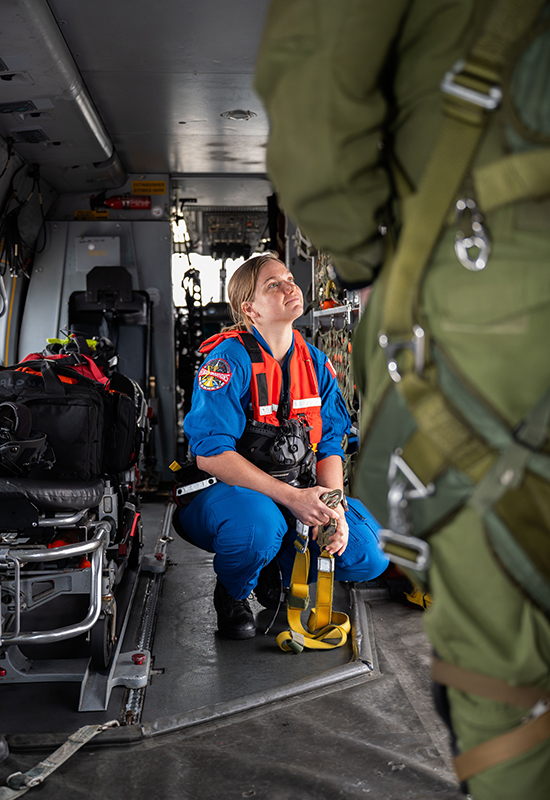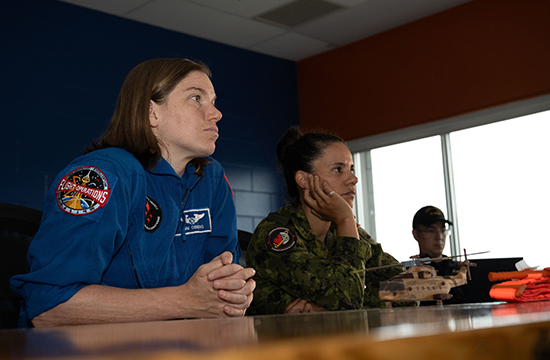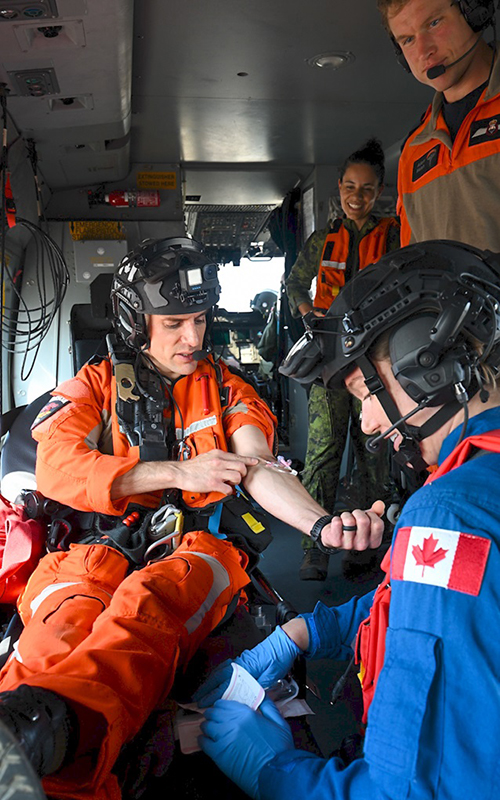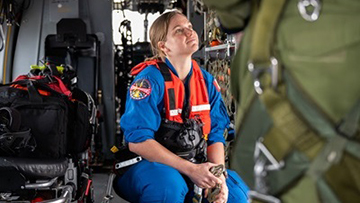October 14, 2025 – Royal Canadian Air Force
Estimated read time – 2:45

Caption
Canadian Space Agency Astronaut Dr. Jenni Gibbons is briefed on the hoisting operations in a CH-149 Cormorant helicopter during her visit to 19 Wing Comox, B.C. on September 8.
Photo: S1 Brendan Gibson, Canadian Armed Forces.
In preparation for her role as a backup astronaut for the upcoming NASA Artemis II mission to orbit the moon, Canadian Space Agency (CSA) astronaut Dr. Jenni Gibbons trained with 442 Transport and Rescue Squadron at 19 Wing Comox.
From September 8 to 12, Dr. Gibbons integrated high-intensity search and rescue (SAR) training into her astronaut preparation. While at 19 Wing Comox, she trained alongside Royal Canadian Air Force (RCAF) SAR technicians, pilots, and flight engineers, learning how crews manage complex helicopters, coordinate crews in tightly confined spaces, and deliver lifesaving care under extreme conditions.
“Training with the SAR community is an opportunity to simulate scenarios that mirror the challenges of spaceflight,” said Dr. Gibbons. “We call it the ‘operator mindset’—a critical asset for astronauts expected to operate advanced systems, manage cognitive loads, and respond to emergencies in cramped quarters. The folks at 442 Squadron live this mindset every day, and there’s a lot to learn from them.”

Caption
Canadian Space Agency Astronaut, Dr. Jenni Gibbons and Canadian Space Agency, Canadian Astronaut Coordination Officer, Capt Erin Edwards, are briefed on medical procedures by Search and Rescue Technicians at 442 Squadron during her visit in 19 Wing Comox, B.C. on September 8.
Photo: S1 Brendan Gibson, Canadian Armed Forces.
19 Wing Comox, home to much of Canada’s SAR training, offered the ideal setting for the best practices exchange.
On September 9, Dr. Gibbons joined 442 Squadron on a real-world MEDEVAC of a patient from the MS Queen Elizabeth cruise ship 20 kilometers west of Nootka Island. Flying aboard the CH-149 Cormorant helicopter, she observed firsthand the coordination between SAR Technicians and aircrew as they delivered in-flight medical care.
For the squadron, the visit offered a unique glimpse into the future of space exploration—and a chance to contribute directly to Canada’s role in the Artemis II program.

Caption
Canadian Space Agency Astronaut Dr. Jenni Gibbons practices intravenous procedures while flying in a CH-149 Cormorant during her visit to 19 Wing Comox, B.C. on September 8.
Photo: Aviator Zhi Sheng Lin, Canadian Armed Forces.
“Last year, Jenni trained with the RCAF at 3 Canadian Forces Flying Training School to learn rotary-wing flying, so it was great to build on that foundation here at 19 Wing,” said Captain (Capt) Matt Welsh from 442 Squadron. “This phase of training focused less on flying technique and more on how teams operate”
Capt Erin Edwards, the 3 Canadian Space Division Astronaut Coordination Officer from the Johnson Space Center is responsible for ensuring the coordination and execution of all astronaut training prior to assignment.
“Similar to the military, we lean forward into training to make sure it makes sense for the mission which is changing from space station ops to lunar ops. Leveraging assets and knowledge we have available on Earth that are a close analog to the stresses and challenges we see in space flight while building upon the fantastic training that astronauts receive, makes this type of collaboration with the RCAF incredibly valuable. It’s cool to see how things that don’t seem related can benefit outside of regular spheres. Jenni and the astronaut corps also have a lot to pass on to us in the CAF about how to handle unique pressures and working as members of incredibly complex and globally integrated teams. It’s a win-win, for sure,” said Capt Edwards.
Dr. Gibbons, a mechanical engineer and former Cambridge assistant professor, was selected by the CSA in 2017, currently serving as the Canadian backup astronaut for Artemis II. The mission will see RCAF Colonel (Col) and CSA Astronaut Jeremy Hansen become the first Canadian to travel beyond low Earth orbit—an historic milestone for Canada’s space program. As Col Hansen’s designated backup, Dr. Gibbons plays a critical role in mission readiness and continuity, and her training reflects the same high standards and operational demands.
Next, Dr. Gibbons will return to Houston and continue preparations for launch of the Artemis II Mission that is scheduled to launch between February and April 2026.

